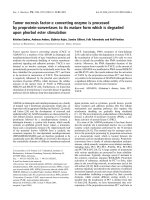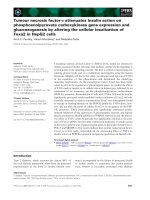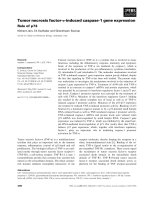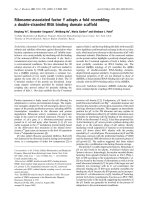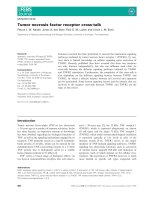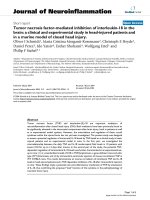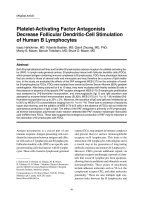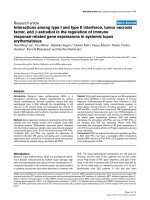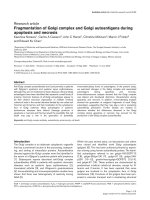Báo cáo y học: "Tumor necrosis factor alpha and epidermal growth factor act additively to inhibit matrix gene expression by chondrocyte" pptx
Bạn đang xem bản rút gọn của tài liệu. Xem và tải ngay bản đầy đủ của tài liệu tại đây (1.47 MB, 12 trang )
Available online />
Research article
Open Access
Vol 7 No 1
Tumor necrosis factor alpha and epidermal growth factor act
additively to inhibit matrix gene expression by chondrocyte
Aaron R Klooster and Suzanne M Bernier
CIHR Group in Skeletal Development and Remodeling, Department of Anatomy and Cell Biology, The University of Western Ontario, London, Ontario,
Canada
Corresponding author: Suzanne M Bernier,
Received: 26 Jul 2004 Revisions requested: 23 Sep 2004 Revisions received: 8 Oct 2004 Accepted: 22 Oct 2004 Published: 29 Nov 2004
Arthritis Res Ther 2005, 7:R127-R138 (DOI 10.1186/ar1464)
© 2004 Klooster and Bernier., licensee BioMed Central Ltd.
This is an Open Access article distributed under the terms of the Creative Commons Attribution License ( />2.0), which permits unrestricted use, distribution, and reproduction in any medium, provided the original work is cited.
/>
Abstract
The failure of chondrocytes to replace the lost extracellular
matrix contributes to the progression of degenerative disorders
of cartilage. Inflammatory mediators present in the joint regulate
the breakdown of the established matrix and the synthesis of
new extracellular matrix molecules. In the present study, we
investigated the effects of tumor necrosis factor alpha (TNF-α)
and epidermal growth factor (EGF) on chondrocyte morphology
and matrix gene expression. Chondrocytes were isolated from
distal femoral condyles of neonatal rats. Cells in primary culture
displayed a cobblestone appearance. EGF, but not TNF-α,
increased the number of cells exhibiting an elongated
morphology. TNF-α potentiated the effect of EGF on
chondrocyte morphology. Individually, TNF-α and EGF
diminished levels of aggrecan and type II collagen mRNA. In
combination, the effects of TNF-α and EGF were additive,
indicating the involvement of discrete signaling pathways. Cell
viability was not compromised by TNF-α or by EGF, alone or in
combination. EGF alone did not activate NF-κB or alter NF-κB
activation by TNF-α. Pharmacologic studies indicated that the
effects of TNF-α and EGF alone or in combination were
independent of protein kinase C signaling, but were dependent
on MEK1/2 activity. Finally, we analyzed the involvement of Sox9 using a reporter construct of the 48 base pair minimal
enhancer of type II collagen. TNF-α attenuated enhancer activity
as expected; in contrast, EGF did not alter either the effect of
TNF-α or basal activity. TNF-α and EGF, acting through distinct
signaling pathways, thus have additive adverse effects on
chondrocyte function. These findings provide critical insights
into the control of chondrocytes through the integration of
multiple extracellular signals.
Keywords: chondrocyte, epidermal growth factor, extracellular matrix, signaling, tumor necrosis factor alpha
Introduction
The role of epidermal growth factor (EGF) in the development of articular cartilage and the pathogenesis of arthritis
is poorly understood. During development, EGF produced
by the apical ectodermal ridge promotes the outgrowth of
the limb bud mesoderm; however, migration away from the
apical ectodermal ridge and downregulation of EGF
expression in the mesodermal cells is necessary for differentiation of this cell population into chondrocytes [1]. We
previously found that EGF encourages expansion of early
committed chondrocytes but prevents the expression of
link protein and aggrecan [2], two extracellular matrix components that are necessary for proper cartilage organization [3]. Proteoglycan accumulation is inhibited following
treatment of mature articular chondrocytes with EGF in a
monolayer or an organ culture [4,5]. We recently demonstrated an increase in proton efflux from chondrocytes
treated with EGF resulting in localized acidification of the
microenvironment that may contribute to altering both
responsiveness of chondrocytes to extracellular stimuli and
the activity of matrix metalloproteinases [6]. EGF is detectable in the synovial fluid of rheumatoid arthritis patients and
influences the growth of synovial cells [7]. However, the
effects on cartilage of EGF, alone or in conjunction with
other mediators associated with inflammation, are poorly
characterized.
BIS = bisindolylmaleimide; EGF = epidermal growth factor; ERK = extracellular signal-regulated kinase; IL = interleukin; MAPK = mitogen-activated
protein kinase; MEK1/2 = mitogen-activated protein kinase kinase 1 and 2; NF = nuclear factor; PARP = poly(ADP ribose) polymerase; PKC = protein
kinase C; TNF-α = tumor necrosis factor alpha; TUNEL = terminal deoxynucleotidyl transferase-mediated dUTP nick end-labeling; U0124 = 1,4diamino-2,3-dicyano-1,4-bis(methylthio) butadiene; U0126 = 1,4-diamino-2,3-dicyano-1,4-bis[2-aminophenylthio] butadiene.
R127
Arthritis Research & Therapy
Vol 7 No 1
Klooster and Bernier
Among the inflammatory mediators associated with joint
diseases, tumor necrosis factor alpha (TNF-α) is well established as a key mediator in the progression of cartilage
degeneration. High levels of TNF-α are detected in the synovial lining of rheumatic joints and in chondrocytes of osteoarthritic joints [8]. TNF-α promotes further expression of
cytokines and chemokines by synovial cells and chondrocytes, thereby sustaining a renewal of local inflammatory
mediators (reviewed in [9,10]). The presence of TNF-α correlates with a general loss of cartilage matrix molecules,
such as type II collagen and aggrecan, due to increased
production of matrix metalloproteinases and a reduction in
synthesis of matrix molecules [11]. We recently demonstrated that activation of the NF-κB and mitogen-activated
protein kinase (MAPK)/extracellular signal-regulated kinase
(ERK) signaling pathways contributes to the TNF-α-mediated reduction of transcription of the type II collagen and
link protein genes, as well as to a reduction in the steadystate mRNA levels of these key extracellular matrix components [12]. In rheumatic joints, elevated levels of EGF in the
synovial fluid contribute to hyperplasia of the synovial lining,
where synovial cells display increased expression of the
EGF receptor ErbB-2 (also known as c-neu or HER2)
[7,13,14] and amplify IL-1-mediated release of prostaglandin E2 from synovial cells [15]. However, the combined
effects of EGF and TNF-α have not been investigated
previously.
The objective of the present study was to determine
whether EGF potentiates the response of chondrocytes to
TNF-α. We investigated changes in chondrocyte morphology and function. The expression of type II collagen that is
responsible for the structural integrity of articular cartilage
and aggrecan that imparts resilience to the tissue were
used as measures of chondrocyte function. Co-administration of TNF-α and EGF in the present study resulted in a
marked increase in the proportion of elongated cells and an
additive decrease in matrix gene expression. These
changes in morphology and gene expression were found to
be controlled in part by the MAPK pathway. Furthermore,
EGF exerts its effects on matrix gene expression through a
pathway independent of Sox-9.
and 10 mM HEPES (Invitrogen Life Technologies Inc., Burlington, ON, Canada). Culture media was replaced every 3
days. Culture medium was replaced with serum-free
medium 16–20 hours prior to experiments.
Primary chondrocyte cultures were treated with TNF-α (30
ng/ml; Sigma Aldrich, Oakville, ON, Canada), with EGF (10
ng/ml; Sigma Aldrich) or with vehicle (phosphate-buffered
saline + 0.01% bovine albumin; Roche Diagnostics, Laval,
QC, Canada) in serum-free medium. These concentrations
were previously found to elicit maximal responses from
these cells [6,12]. For analysis of signaling pathways, cells
were treated prior to addition of TNF-α or EGF with pharmacologic inhibitors including 2-[1-(3-dimethylaminopropyl)-1H-indol-3-yl]-3-(1H-indol-3-yl)-maleimide (10 µM
bisindolylmaleimide [BIS] I, protein kinase C [PKC] inhibitor), or 2,3-bis(1H-indol-3-yl)-N-methylmaleimide (10 µM
BIS V, inactive analog of BIS I), 1,4-diamino-2,3-dicyano1,4-bis(2-aminophenylthio)-butadiene (10 µM U0126,
mitogen-activated protein kinase kinase 1 and 2 [MEK1/2]
inhibitor; Promega, Madison, WI, USA), and 1,4-diamino2,3-dicyano-1,4-bis(methylthio)-butadiene (10 µM U0124,
inactive analog of U0126). BIS I was used at a concentration that was greater than 500 times the inhibitory concentration 50% for conventional PKCs and twice the inhibitory
concentration 50% for PKCζ. U0126 was used at a concentration previously found to be effective for inhibiting the
phosphorylation of ERK1/2 [12]. The pharmacologic
agents were obtained from EMD Biosciences (Calbiochem, La Jolla, CA, USA) unless otherwise stated.
Imaging
Digital images of confluent monolayers were obtained
using a Sony Power HAD 3CCD mounted onto a Nikon
TMS inverted phase-contrast microscope (20 × objective
magnification) (Nikon Canada Inc., Mississauga, ON, Canada). Images were acquired with NorthernEclipse V.5 software (Empix, Mississauga, ON, Canada). For the present
study, an elongated cell was defined as having a predominant axis length exceeding three times the maximum width
of the cell. The number of elongated cells per field of view
(1.376 mm2) was counted and averaged.
Materials and methods
RNA extraction and northern blot analysis
Primary cell culture
Total RNA was collected from cells using the acid–guanidium–phenol–chloroform extraction method (Trizol; Invitrogen Life Technologies Inc.), according to the
manufacturer's instructions. RNA was quantified by ultraviolet spectrophotometry. Total RNA (10 µg) was resolved
on a 1.1% agarose gel containing formaldehyde. Equivalent loading of samples was verified by ethidium bromide
staining before RNA was transferred to Nytran membranes
(Schleicher & Schuell, Keene, NH, USA). RNA was fixed to
the Nytran membrane by incubation at 80°C for 2.5 hours
under vacuum. cDNA probes corresponding to the mouse
Articular chondrocytes were isolated from the distal femoral condyles of 1-day-old Sprague–Dawley rats (Charles
River, St Hyacinthe, QC, Canada) as previously described
[12]. The Animal Use Subcommittee of the University of
Western Ontario Council on Animal Care approved the use
of rats for these studies. Cells were plated at a density of
4.25 × 104 cells/cm2 on tissue culture-treated plates (Falcon; BD Biosciences, Mississauga, ON, Canada) and cultured in RPMI 1640 media supplemented with 5% fetal
bovine serum, 100 U/ml penicillin, 100 U/ml streptomycin
R128
Available online />
C-propeptide of type II collagen (pKN225) [16], to 18S
rRNA (DECAtemplate 18S mouse; Ambion, Austin, TX,
USA), and to the C-terminus of rat aggrecan [17,18] were
labeled with [α32P]dCTP (3000 Ci/mmol; Perkin Elmer,
Woodbridge, ON, Canada) by a random-primed oligonucleotide method (Prime-a-gene labeling kit; Promega).
Membranes were hybridized with cDNA probes and processed as described previously [19].
Preparation of cell extracts and immunoblotting
Cell extracts were prepared as described previously [12].
Equivalent amounts of protein (15–30 µg) were resolved
by electrophoresis on 7.5% polyacrylamide-SDS gels. Protein was transferred to nitrocellulose membrane (Schleicher & Schuell) by electroblotting. Transfer and
equivalent loading was verified by subsequent staining with
Ponceau Red (3-hydroxy-4-(2-sulfo-4-[4-sulfophenylazo]phenylazo)-2,7-napthalenedisulfonic acid) [20]. Immunoblotting was performed by blocking the membrane for 1 hour
with 5% non-fat milk (Carnation, North York, ON, Canada)/
TBS 0.5% Tween. Membranes were incubated with antibodies for poly(ADP ribose) polymerase (PARP) (Santa
Cruz Biotechnology, Santa Cruz, CA, USA), phospho-specific ERK1/2 (Anti-active MAPK; Promega) or ERK1 and
ERK2 (Santa Cruz Biotechnology) according to the manufacturer's instructions. Target signals were detected with
SuperSignal West Pico Chemiluminescent Substrate
(Pierce Biotechnology Inc., Rockford, IL, USA) and exposure to Hyperfilm ECL (Amersham Biosciences, Baie
d'Urfé, QC, Canada).
Apoptosis analysis
Cells were seeded on Permanox chamber slides (Nalge
Nunc, Naperville, IL, USA) at a density of 550 cells/mm2.
Following treatment with factors, slides were fixed with 4%
formalin solution. Apoptosis was assessed by the terminal
deoxynucleotidyltransferase end-labeling with fluoresceindUTP (TUNEL) method (Roche Diagnostics) as described
in the manufacturer's instructions. Positive controls were
treated for 10 min with DNAse I (Roche Diagnostics) to
induce DNA breaks. Fluorescein activity was imaged by
laser scanning confocal microscopy (LSM 510 Meta; Carl
Zeiss Microscopy, Jena, Germany).
MTT assay for cell viability
Cell viability was analyzed using the Cell Proliferation Kit I
(MTT; Roche Diagnostics) following the manufacturer's
instructions. Cells were seeded on 96-well plates at 400
cells/mm2, were cultured for 5 days and were then treated
with TNF-α, or with EGF, or with TNF-α + EGF for an additional 24 hours. The colorimetric reaction was read on a
µQuant
spectrophotometer
(Bio-Tek
Instruments,
Winooski, VT, USA) at 550 nm and 690 nm. The reading at
690 nm was used as a reference wavelength to calculate a
corrected absorbance (A550 – A690).
Transfections and luciferase reporter analysis
Chondrocytes were transfected with reporter constructs
for NF-κB (Clontech, Palo Alto, CA, USA) or the type II collagen enhancer region (pGl3 4 × 48; a kind gift from Dr TM
Underhill, The University of British Columbia, Vancouver,
BC, Canada) [21]. Briefly, per transfection reaction, 0.1 µg
reporter DNA and 2 ng PRL-SV40, a constitutively
expressed renilla luciferase plasmid for monitoring transfection efficiency, were incubated with Fugene 6 transfection reagent (Roche Diagnostics). The mixture was added
to a well of a 48-well plate and overlayed with 3.5 × 104
cells in serum-free culture medium. After 5 hours, medium
containing serum was added to the wells. The following
day, cells were treated with TNF-α (30 ng/ml), with EGF
(10 ng/ml), with a combination of both or with vehicle in
serum-free medium for 24 hours. The cells were lysed with
1 × Reporter Lysis Buffer (Promega) and luciferase activity
quantified using the Dual Luciferase Assay System
(Promega).
Nuclear extract preparation and electrophoretic mobility
shift assays
Isolation of nuclear extracts and the electrophoretic mobility shift assay were performed as previously described
[12,22]. The double-stranded oligonucleotide containing
the κB recognition sequence was purchased from Santa
Cruz Biotechnology.
Densitometry and statistical analysis
All data are representative of at least three independent
experiments. Bands appearing on exposed film were analyzed using Kodak Digital Science software (Eastman
Kodak, Rochester, NY, USA). Relative expression levels of
type II collagen mRNA and aggrecan mRNA were standardized to the expression levels of 18S rRNA. One-way
analysis of variance or repeated-measures analysis of variance followed by Tukey–Kramer post-test comparisons
was performed to determine the statistical significance of
differences among means (GraphPad Prism version 3.00;
GraphPad Software, San Diego, CA, USA).
Results
Effects of TNF-α and EGF on chondrocyte morphology
The cellular morphology reflects the differentiation status of
cells such as chondrocytes. For example, a change from a
rounded to a more elongated morphology in response to
EGF by CFK2 chondrocytic cells is associated with a
diminished onset of expression of aggrecan and link protein
gene [2]. To determine whether the morphology of primary
chondrocytes expressing the matrix was affected by TNF-α
or EGF, live cultures were examined by phase-contrast
microscopy (Fig. 1a) and the number of elongated cells per
field was quantified (Fig. 1b).
R129
Arthritis Research & Therapy
Vol 7 No 1
Klooster and Bernier
Figure 1
Tumor necrosis factor alpha (TNF-α) enhances elongated cell morphology induced by epidermal growth factor (EGF). Confluent monolayers of
(EGF)
chondrocytes were treated with vehicle, TNF-α (30 ng/ml), EGF (10 ng/ml) or TNF-α + EGF for 24 hours. (a) Cell morphology was observed by
phase contrast microscopy. Arrowheads indicate spinous processes that appear following incubation with EGF or TNF-α + EGF. An elongated cell
is defined as having a predominant axis with a length exceeding three times the maximum width of the cell. Digital images of live cultures were captured at 20 × objective magnification. Bar = 100 µm. Images shown are representative of three independent experiments. (b) The total number of
elongated cells per field (1.376 mm2) were counted, averaged for at least three independent experiments (n = 3–5), and analyzed by analysis of variance. a Significant difference from control (P < 0.01), b significant difference from control (P < 0.001) and significant difference from EGF-treated
cells (P < 0.01).
Previous studies established concentrations for TNF-α (30
ng/ml) [12] and EGF (10 ng/ml) [6] for maximal activation
of signaling pathways in primary chondrocytes. Following a
24-hour treatment with vehicle (control) or TNF-α, the monolayers exhibited a 'cobblestone' appearance. In contrast,
treatment with EGF promoted cell elongation, a change
that was significantly potentiated by the presence of TNFα. The distribution and arrangement of actin filaments were
analyzed by phalloidin labeling. An increase in stress fibers
was observed in elongated cells; however, the density of
cells and prevalence of filamentous actin throughout the
monolayer precluded any further quantitative analysis (data
not shown).
Effects of TNF-α and EGF on levels of aggrecan and type
II collagen mRNA
We previously demonstrated that TNF-α reduces transcriptional expression of type II collagen and link protein genes
[12]. In the present study, we characterized the effect of
TNF-α on aggrecan mRNA levels and determined whether
EGF altered type II collagen and aggrecan mRNA levels in
the presence or absence of TNF-α. Cultures were treated
with TNF-α or EGF individually or in combination (TNF-α +
EGF) and the levels of aggrecan and type II collagen mRNA
were analyzed (Fig. 2). Following 24 hours of treatment
R130
with TNF-α, levels of aggrecan and type II collagen mRNA
were decreased by 42 ± 4% and 39 ± 2%, respectively.
EGF alone decreased levels of aggrecan and type II collagen mRNA by 44 ± 5% and 42 ± 4%, respectively. Treatment of chondrocytes with TNF-α + EGF resulted in
additive losses of aggrecan and type II collagen mRNA (93
± 2% and 79 ± 4%, respectively). Treatment with TNF-α
for 4 hours prior to the addition of EGF for the remainder of
the 24 hours resulted in comparable decreases in levels of
aggrecan and type II collagen mRNA (89 ± 2% and 81 ±
7%, respectively; data not shown). The combination of
TNF-α and EGF therefore produces an additive decrease
in both aggrecan and type II collagen mRNA levels, suggestive of discrete signals regulating mRNA expression by
each factor.
TNF-α and EGF do not alter the extent of apoptosis in the
chondrocyte culture
Cultures treated with TNF-α, with EGF or with TNF-α +
EGF were assessed for evidence of apoptosis using an
early marker, PARP (Fig. 3a). PARP is a 116 kDa protein
involved in DNA repair [23] that is cleaved as part of the
caspase cascade initiated in cells undergoing apoptosis.
Cell extracts were immunoblotted for the presence of intact
and cleaved forms of PARP. Neither loss of intact PARP
Available online />
Figure 2
Tumor necrosis factor alpha (TNF-α) + epidermal growth factor (EGF) results in additive reduction in levels of aggrecan and type II collagen mRNA.
additive reduction in levels of aggrecan and type II collagen mRNA
Confluent monolayers of chondrocytes were treated for 24 hours with vehicle (CNTL), TNF-α (30 ng/ml), EGF (10 ng/ml) or TNF-α + EGF (n = 12).
Levels of (a) aggrecan and (b) type II collagen mRNA were analyzed by northern blot of total RNA (10 µg). Changes in levels of (c) aggrecan and
(d) type II collagen mRNA were quantified by densitometry. Levels were normalized to levels of 18S rRNA and data are expressed as the percentage
of control ± standard error of the mean. a Significant difference from control (P < 0.001), b significant difference from TNF-α-treated and EGF-treated
populations (P < 0.001).
nor the appearance of cleaved moieties (85 kDa) was
detected following 24 hours of treatment with TNF-α, with
EGF or with TNF-α + EGF. Interestingly, TNF-α + EGF
increased the amount of PARP present in the chondrocytes. To confirm the lack of apoptosis in factor-treated cultures, the presence of DNA strand breaks was evaluated by
in situ labeling (TUNEL) (Fig. 3b). TUNEL labeling was not
detected following any of the treatments.
Cell viability was also assessed using the MTT assay (Fig.
4). TNF-α did not significantly alter cell viability after 24
hours. EGF caused an increase in metabolism of the tetrazolium salt at 24 hours that was not, however, changed significantly by co-addition of TNF-α, probably reflecting an
increase in chondrocyte number. These results suggest
that reduction in aggrecan and type II collagen mRNA levels induced by TNF-α and EGF are not correlated with
initiation of programmed cell death (Fig. 3) or a decrease in
cell number (Fig. 4).
Figure 3
Apoptosis is not observed following tumor necrosis factor alpha (TNF-α) and/or epidermal growth factor (EGF) treatment Confluent monolayers of
treatment.
chondrocytes were treated with vehicle, TNF-α (30 ng/ml), EGF (10 ng/ml) or TNF-α + EGF for 24 hours. (a) Early stages of apoptosis were
assayed by immunoblot with an antibody specific for intact and cleaved forms of poly(ADP ribose) polymerase (PARP). No cleavage of PARP (i.e.
appearance of a band at 89 kDa) was detected following any of the treatments. Blot shown is representative of three independent experiments. (b)
Apoptosis-induced DNA strand breaks were examined by in situ labeling (terminal deoxynucleotidyl transferase-mediated dUTP nick end-labeling
[TUNEL]) and imaged using confocal microscopy. No TUNEL labeling was detected with any of the treatments. Cells treated with DNAse I to induce
DNA breaks served as a positive control. Bar = 50 µm. Images are representative of three independent experiments.
R131
Arthritis Research & Therapy
Vol 7 No 1
Klooster and Bernier
Figure 4
Figure 5
alpha (TNF-α) maintained in the presence of tumor necrosis factor
Cell viability is and/or epidermal growth factor (EGF)
alpha (TNF-α) and/or epidermal growth factor (EGF). Subconfluent
monolayers of chondrocytes were treated with vehicle, TNF-α (30 ng/
ml), EGF (10 ng/ml) or TNF-α + EGF for 24 hours. Cell viability was
assessed by MTT assay. Data shown are combined from four independent experiments, presented as the mean corrected absorbance ±
standard error of the mean analyzed by repeated-measures analysis of
variance. a Significant difference from control (P < 0.01, n = 4). OD,
optical density.
EGF does not alter NF-κB activation by TNF-α
Several signaling pathways known to mediate the effects of
TNF-α and EGF were next investigated. We previously
demonstrated that primary articular chondrocytes treated
with TNF-α exhibit sustained activation of NF-κB at 24
hours, and that NF-κB partially mediated the reduction in
type II collagen mRNA induced by TNF-α [12]. To assess
whether changes in NF-κB activity contribute to the
observed decrease in aggrecan and type II collagen mRNA,
chondrocytes were transfected with a κB-driven reporter to
detect functional activation of NF-κB (Fig. 5a). As
expected, TNF-α significantly increased reporter levels. In
contrast, EGF did not activate NF-κB or alter activation of
NF-κB by TNF-α. Furthermore, sustained NF-κB activation
induced by TNF-α was unchanged by EGF as determined
by the electrophoretic mobility shift assay (Fig. 5b). The
heightened decrease in aggrecan and type II collagen
mRNA induced by TNF-α + EGF was therefore not the
result of altered NF-κB activation.
Inhibition of PKC does not prevent reduction in levels of
aggrecan or type II collagen mRNA by TNF-α and EGF
TNF-α and EGF have been found to activate PKC in other
cell types. The role of PKC signaling in the reduction of
aggrecan and type II collagen mRNA by TNF-α and EGF
was examined using a pharmacologic inhibitor of PKC (Fig.
6). Cultures were pretreated with the PKC inhibitor BIS I at
a concentration known to inhibit activation of several PKC
isoforms, specifically PKCα, PKCβI, PKCβII, PKCγ, PKCδ,
PKCε, and PKCζ [24,25], or with BIS V, an inactive analog
of BIS I. TNF-α and/or EGF were added and the mRNA levels were analyzed by northern blot. Pretreatment with either
BIS I or BIS V did not prevent the reduction in levels of
aggrecan and type II collagen mRNA by TNF-α, by EGF or
R132
tumor necrosis factor alpha (TNF-α)
Epidermal growth factor (EGF) does not alter NF-κB activation by
tumor necrosis factor alpha (TNF-α). (a) Chondrocytes transfected with
a κB reporter were treated with TNF-α (30 ng/ml), EGF (10 ng/ml) or
TNF-α + EGF. Reporter activity was assessed after 24 hours. Data
were corrected for a constitutively expressed reporter (pSV40-RL), presented as mean relative luciferase units (RLU) ± standard error of the
mean, and analyzed using one-way analysis of variance followed by a
Tukey–Kramer post-test. a Significant difference from basal κB activity
at P < 0.001 and no significant difference between TNF-α and TNF-α +
EGF. (b) The effect of EGF on sustained NF-κB activity induced by
TNF-α was determined by treating confluent chondrocytes with TNF-α
(30 ng/ml) alone for 24 hours, EGF (10 ng/ml) alone for 20 hours, or
TNF-α for 4 hours followed by the addition of EGF (10 ng/ml) for cotreatment for a further 20 hours. Nuclear extracts were prepared and
analyzed by electrophoretic mobility shift assay for activation of NF-κB.
The reporter assay and band shift shown are representative of three
independent experiments.
by TNF-α + EGF. Activation of PKC thus does not appear
to be involved in the regulation of matrix gene expression by
TNF-α and EGF. Neither BIS I nor BIS V treatment alone
significantly altered the levels of aggrecan and type II collagen mRNA.
Available online />
Figure 6
the chondrocytes treated with U0124 or with U0126 followed by treatment with either vehicle or TNF-α exhibited
similar morphology (Fig. 7a) to that observed in the
absence of pharmacological agents (Fig. 1).
The number of elongated cells per field was also counted
(Fig. 7b). The number of elongated cells induced by EGF
and by TNF-α + EGF was markedly reduced following pretreatment with U0126. Cultures treated with U0124 followed by EGF or by TNF-α + EGF exhibited changes in the
number of elongated cells comparable with vehicle-pretreated cultures. Changes in morphology in response to
EGF and to TNF-α + EGF are thus dependent on a MEK1/
2-regulated process.
Inhibition of the MAPK pathway prevents TNF-α and
EGF-mediated loss of aggrecan and type II collagen
mRNA
We previously demonstrated that activation of the MAPK
signaling cascade contributed to a reduction in type II collagen mRNA levels [12]. The involvement of the MAPK/
ERK pathway in the reduction in aggrecan and type II collagen mRNA levels by EGF and TNF-α was investigated.
Cells were pretreated with U0124 or U0126 followed by
the addition of TNF-α and/or EGF or vehicle for 24 hours
(Fig. 8). Cultures treated with the inactive inhibitor exhibited
no change in either the basal levels of mRNA (data not
shown) or the extent of reduction in aggrecan or type II collagen mRNA levels from that of untreated cultures (Fig. 2).
U0126 prevented the losses mediated by the individual
factors and partially protected against the effect of TNF-α
and EGF in combination.
(TNF-α) or epidermal growth factor (EGF)
aggrecan of type II kinase C does by tumor necrosis factor alpha
Inhibitionandprotein collagen mRNAnot prevent reduction in levels of
aggrecan or type II collagen mRNA by tumor necrosis factor alpha
(TNF-α) and epidermal growth factor (EGF). Confluent monolayers of
chondrocytes were pretreated with 10 µm bisindolylmaleimide (BIS) I
or the structurally related, nonfunctional analog BIS V (10 µm) for 15
min, followed by treatment with TNF-α (30 ng/ml), EGF (10 ng/ml) or
TNF-α + EGF in combination for 24 hours. Levels of (a) aggrecan and
(b) type II collagen mRNA were determined by northern blot analysis of
total RNA (10 µg). Levels were normalized to levels of 18S rRNA and
data are expressed as the percentage of respective controls ± standard
error of the mean (n = 4–6). a Significant difference from respective
control populations (P < 0.05), b significant difference from populations
treated individually with TNF-α or EGF (P < 0.001).
Changes in cell morphology induced by EGF or the
combination of TNF-α and EGF are suppressed by
inhibition of MAPK
EGF is a well-characterized activator of the MAPK/ERK
pathway [26]. We investigated whether the changes
observed in cell morphology were dependent on the
MAPK/ERK pathway. Chondrocytes were treated with the
selective inhibitor of MEK1/2 activation, U0126, at a
concentration previously found to inhibit ERK1/2 phosphorylation in these cells [12], or the inactive analog U0124
followed by TNF-α and/or EGF or vehicle. After 24 hours,
To determine the MAPK responsiveness of chondrocytes
to the combination of these factors, the phosphorylation of
ERK1/2 was assessed. Cell extracts were collected from
cultures treated for 4 hours with vehicle or with TNF-α prior
to the addition of EGF, and were immunoblotted with antibody specific for phosphorylated forms of ERK1/2 (Fig. 9).
In a previous study [12], we demonstrated phosphorylation
of ERK1/2 within 15 min of the addition of TNF-α. In the
present study, we found that phosphorylation of ERK1/2
returned to control levels after 4 hours of treatment with
TNF-α. Phosphorylation of both ERK1 and ERK2 by EGF
was apparent after 5 min and had not diminished by 30 min
in the vehicle-treated cells. As both simultaneous and
sequential addition of TNF-α and EGF produced comparable reductions in matrix gene mRNA levels, the MAPK
response to EGF was assessed in the presence or
absence of a 4-hour TNF-α pretreatment. Cultures that
received TNF-α pretreatment followed by EGF had levels of
ERK1/2 phosphorylation comparable with those cultures
treated with EGF alone. An increase in the level of phosphorylation therefore did not contribute to the greater loss
of matrix gene mRNA expression.
R133
Arthritis Research & Therapy
Vol 7 No 1
Klooster and Bernier
Figure 7
reduced in cell morphology induced by the combination of tumor necrosis factor alpha (TNF-α) + epidermal growth factor (EGF) are partially
Changesby inhibition of MEK1/2
reduced by inhibition of MEK1/2. (a) Confluent monolayers of chondrocytes were pretreated with U0124 (10 µM) or U0126 (10 µM) for 15 min followed by 24-hour treatment with TNF-α (30 ng/ml), EGF (10 ng/ml) or TNF-α + EGF. Digital images of live cultures were captured at 20 × objective
magnification. Bar = 100 µm. Images are representative of two independent experiments. (b) An elongated cell is defined as having a predominant
axis with a length exceeding three times the maximum width of the cell. The total number of elongated cells per field (1.376 mm2) were counted,
averaged for three independent experiments (n = 3), and analyzed by analysis of variance. a Significant difference from respective control (P < 0.05),
b significant difference from respective control (P < 0.001), c significant difference from U0124 + EGF-treated cells (P < 0.01), d significant difference from U0124 + EGF-treated cells (P < 0.05), e significant difference from U0124 + TNF-α + EGF-treated cells (P < 0.001).
Effects of EGF on type II collagen mRNA are independent
of the Sox-9 response region of the type II collagen
enhancer
Expression of both type II collagen and aggrecan genes is
regulated by a transcriptional complex containing members
of the Sox family, namely Sox-5, Sox-6, and Sox-9 [27,28].
A Sox-9 regulatory element resides in the type II collagen
enhancer. To determine whether the reduction in type II
collagen mRNA levels by EGF involves the minimal
enhancer region, chondrocytes were transfected with a
reporter construct for this 48 base pair region [21] and
were treated with TNF-α and/or EGF or with vehicle (Fig.
10). As previously demonstrated [12], TNF-α markedly
reduced activity at this regulatory region consistent with
impairment of Sox-9 binding or activity. In contrast, EGF did
not alter the activity of the enhancer region and the effect
R134
of TNF-α + EGF was not significantly different from that of
TNF-α alone. These results indicate that the EGF-mediated
reduction in levels of type II collagen mRNA is independent
of the minimal enhancer regulatory region and, therefore,
probably independent of Sox-9 regulation.
Discussion
The morphology of cells is regulated by extracellular signals
including soluble mediators and a matrix. Moreover, a
relationship exists between the morphology and the state of
differentiation. In the present study we investigated the
effects of TNF-α, a factor that did not alter cell morphology,
and the effects of EGF, a factor that induced a change in
cell morphology. It is well established that removal of
chondrocytes from their environment rich in extracellular
matrix to a two-dimensional culture causes a change in
Available online />
Figure 8
tumor necrosis factor of aggrecan and type II collagen mRNA
Inhibition of the mitogen-activated protein kinase pathway prevents
(EGF)-mediated loss alpha (TNF-α) and epidermal growth factor
tumor necrosis factor alpha (TNF-α) and epidermal growth factor
(EGF)-mediated loss of aggrecan and type II collagen mRNA. Confluent
chondrocytes were pretreated with U0124 (10 µm, inactive analog of
U0126) or U0126 (10 µm, a MEK1/2 inhibitor), for 15 min, followed by
treatment with TNF-α (30 ng/ml), EGF (10 ng/ml) or TNF-α + EGF for
24 hours. Levels of (a) aggrecan and (b) type II collagen mRNA were
assessed by northern blot analysis of total RNA (10 µg). Levels were
normalized to levels of 18S rRNA and data are expressed as the percentage of respective control ± standard error of the mean (n = 5). a
Significant difference from respective control (P < 0.001), b significant
difference from cultures treated individually with TNF-α or EGF (P <
0.01), c significant difference from cultures treated with U0124 followed by addition of TNF-α + EGF (P < 0.05).
morphology from rounded/cuboidal to more flattened and
spread cells [29]. These morphological changes are
accompanied by changes in the organization of the actin
cytoskeleton [30]. Coincident with the change in chondrocyte shape is a loss of expression of phenotypic markers
such as type II collagen and aggrecan [29,31,32], a phenomenon referred to as dedifferentiation. In addition, nonmatrix factors can influence the organization of the actin
cytoskeleton and can have profound effects on differentiation of chondrocytes. For example, bone morphogenetic
protein-7 and IL-1 promote and restrict chondrogenesis,
Figure 9
alpha (TNF-α)
growth factor (EGF) extracellular signal-regulated kinase (ERK)1/2
phosphorylation are observed in chondrocytes treated necrosis factor
Comparable levels ofalone or in combination with tumorwith epidermal
phosphorylation are observed in chondrocytes treated with epidermal
growth factor (EGF) alone or in combination with tumor necrosis factor
alpha (TNF-α). Confluent monolayers of chondrocytes were treated for
4 hours with TNF-α (30 ng/ml) followed by (a) 15 min treatment or (b)
30 min treatment with EGF (10 ng/ml). Phosphorylation of ERK1/2 was
determined by immunoblot assay using phospho-specific ERK1/2 antibody and ERK1 antibody (antibody against ERK1 is cross-reactive for
ERK2). Blots shown are representative of three independent
experiments.
respectively, through changes in the distribution of focal
adhesion proteins that are essential components of the
cytoskeletal complexes. Their induction or their repression,
respectively, of type II collagen gene expression involves
altering the organization of the actin cytoskeleton [33]. In
the present study, however, while only EGF induced a notable change in cell morphology, both TNF-α and EGF
brought about comparable reductions in the mRNA levels
of cartilage matrix genes. Morphological changes may thus
be linked to expression of a differentiated phenotype for
some inflammatory mediators.
Cell survival is essential for ensuring ongoing homeostatic
maintenance of cartilage and for bringing about repair to
damaged cartilage. Maintaining integrity of the nuclear
material is critical, and the repair of damaged DNA is
dependent on PARP. When a cell initiates apoptosis,
PARP is targeted by caspase 3 and caspase 7, and is
cleaved, rendering the enzyme inactive (properties of PARP
are reviewed in [34,35]). Furthermore, in a caspase-independent manner, overactivation of PARP can lead to cell
death through the release of apoptosis-inducing factor
R135
Arthritis Research & Therapy
Vol 7 No 1
Klooster and Bernier
Figure 10
differentially regulate the activity of tumor necrosis factor alpha (TNF-α)
Epidermal growth factor (EGF) and the type II collagen enhancer
differentially regulate the activity of the type II collagen enhancer.
Chondrocytes were co-transfected with the type II collagen enhancer
luciferase reporter and the pSV40-RL constructs. The transfected cells
were treated with vehicle (CNTL), TNF-α (30 ng/ml), EGF (10 ng/ml) or
TNF-α + EGF, and the reporter activities were analyzed after 24 hours.
Values of relative luciferase expression (corrected for transfection efficiency) were compared using one-way analysis of variance followed by
a Tukey–Kramer post-test, and are presented as the mean ± standard
error of the mean. a Significantly different from others at P < 0.001.
Data are representative of three independent experiments. RLU, relative
luciferase units.
[35]. In the present study, apoptosis was not initiated by
TNF-α and/or EGF as there was no cleavage of PARP and
no evidence of DNA fragmentation (TUNEL staining). TNFα and EGF separately had no effect on levels of PARP;
however, when TNF-α and EGF were combined, increased
levels of PARP were found. It is not clear whether the
increase in PARP is due to increased de novo synthesis or
to prevention of turnover. A similar phenomenon has been
observed in retinal tissue following ischemia-reperfusion
injury [36], another situation in which multiple inflammatory
mediators are present. The upregulation of PARP by the
combination of TNF-α and EGF suggests a protective
response by chondrocytes as a certain cellular threshold
for tolerance is exceeded. Furthermore, PARP can mediate
transcriptional suppression through direct interaction with
promoter DNA or modification of regulatory transcription
factors such as NF-κB. Further investigation would be
needed to determine whether PARP is involved in the
reduced mRNA levels of type II collagen and aggrecan.
TNF-α and EGF activate several intracellular signaling pathways through their respective receptors or via cross-talk of
pathway components. The concentrations of factors used
in this study are sufficient to elicit maximal responses in
these chondrocytes [6,12]. The additive nature of the
decrease in aggrecan and type II collagen mRNA suggests
the involvement of at least two signaling pathways actiR136
vated by TNF-α and EGF. We have previously shown that
TNF-α does not activate p38 in this system [12]. Furthermore, NF-κB activity has been implicated in mediating the
effects of TNF-α and IL-1β on the expression of type II collagen [12,37]. Disruption of the actin cytoskeleton with
cytochalasin D or with latrunculin B results in an increase in
NF-κB activation [38]. Although inducing a change in morphology, EGF did not alter the activity of NF-B, either basal
or that induced by TNF-α. Similarly, PKC is typically
activated in response to TNF-α or EGF and can mediate an
activation of MAPK signaling [39,40]. In the present study,
however, inhibition of several isoforms of PKC did not alter
the observed losses in aggrecan and type II collagen
mRNA. The pharmacological inhibitor of MEK1/2 suppressed mRNA loss and changes in cell morphology. The
MAPK/ERK pathway is thereby at least partially involved in
regulating the aggrecan and type II collagen genes and in
remodeling of the cytoskeleton in response to factors
present during inflammation.
The MAPK/ERK pathway plays an important role in directing alterations of the cytoskeleton. For example, constitutively active MAPK induces morphological changes in
fibroblasts, coinciding with disruption of stress fibers and
disappearance of focal adhesions [41]. The MEK/ERK
pathway is crucial in the control of hepatocyte cell morphology and cell cycle in response to EGF [42]. In
chondrocytes, the MAPK/ERK pathway may have dual
function in controlling the alteration in gene expression during cartilage degeneration and cytoskeletal remodeling.
Induction of dedifferentiation may be a consequence of
proliferation induced by growth factors, a process involving
MAPK that may shift the balance away from differentiated
phenotype towards amplification of the population. When
both TNF-α and EGF are present, inhibition of MEK1/2
failed to completely prevent a reduction in mRNA levels of
matrix components. The level of ERK1/2 phosphorylation
induced by EGF was not altered in the presence of TNF-α,
suggesting that MEK1/2 activity was also not altered and
could be fully inhibited by the concentration of U0126
used. Taken together, these data suggest that although
blockade of MEK1/2 can prevent the loss of aggrecan and
type II collagen mRNA by TNF-α and EGF individually, additional signals beyond the MAPK pathway are probably
involved when the factors are combined.
The intracellular signals that control matrix gene expression
elicit their effects through regulation of gene transcription
or through post-transcriptional modification and turnover of
gene products (i.e. stability of mRNA). A key molecule
involved in the transcriptional regulation of both type II collagen and aggrecan is Sox-9 [28,43,44]. Sox-9 acts by
binding to enhancer regions of the type II collagen gene
and to regulatory regions of the aggrecan gene to drive promoter activity [43]. Although the exact mechanism of loss
Available online />
of aggrecan mRNA in response to TNF-α and EGF remains
unclear, the lack of change in activity at the type II collagen
enhancer in response to EGF suggests that changes in
Sox-9 activity do not mediate the EGF effects. Furthermore,
these results together with the fact that the MAPK/ERK
pathway was activated by EGF in this system suggest that
this region is independent of MAPK/ERK activity. There are,
however, alternate sites within these genes that may govern expression, such as SP1/SP3, C-Krox, and Stat1 [4548]. In addition, activation of signaling pathways can
increase synthesis of proteins responsible for the
breakdown of existing mRNA, thereby increasing mRNA
turnover. In this regard, we previously demonstrated that
TNF-α reduces levels of type II collagen mRNA by approximately 40% when transcription was fully inhibited pharmacologically [12]. The additional loss of mRNA species
following the treatment with both EGF and TNF-α in the
present study suggests that intracellular signals target regulatory elements external to the enhancer-like sequence or
stability of the mRNA.
Conclusion
In this study, changes in chondrocyte phenotype and function were determined following treatment with TNF-α and
EGF, mediators that contribute to sustaining the inflammatory processes associated with arthritis. The effects of this
combination of factors have not been explored previously in
cartilage or in other tissues. The expression of matrix genes
critical for maintaining structural and functional integrity of
cartilage was downregulated additively by TNF-α and EGF
through mechanisms that involved at least two signals convergent on matrix gene regulation. Multiple inflammatory
mediators can therefore profoundly reduce chondrocyte
function and contribute to the progression of cartilage
degeneration through several distinct signaling events.
References
1.
2.
3.
4.
5.
6.
7.
8.
9.
10.
11.
12.
13.
14.
15.
Competing interests
The author(s) declare that they have no competing
interests.
16.
Authors' contributions
ARK, an MSc candidate, participated in the design of the
study, performed all the experiments and analysis, prepared
the figures, and contributed to the writing of the manuscript. SMB conceived of the study, participated in its
design and analysis, and prepared and revised the manuscript. Both authors read and approved the final
manuscript.
17.
18.
19.
Acknowledgements
This work is supported by an operating grant from the Canadian Institutes of Health Research and the Institute of Musculoskeletal Health and
Arthritis (IMH 14095). The authors would like to thank Dr S Jeff Dixon
for critical review of the manuscript.
20.
21.
Dealy CN, Scranton V, Cheng HC: Roles of transforming growth
factor-α and epidermal growth factor in chick limb
development. Dev Biol 1998, 202:43-55.
Bernier SM, Goltzman D: Regulation of expression of the
chondrocytic phenotype in a skeletal cell line (CFK2) in vitro. J
Bone Miner Res 1993, 8:475-484.
Watanabe H, Yamada Y: Chondrodysplasia of gene knockout
mice for aggrecan and link protein. Glycoconj J 2002,
19:269-273.
Prins AP, Lipman JM, McDevitt CA, Sokoloff L: Effect of purified
growth factors on rabbit articular chondrocytes in monolayer
culture. II. Sulfated proteoglycan synthesis. Arthritis Rheum
1982, 25:1228-1238.
Verschure PJ, Joosten LA, van der Kraan PM, Van den Berg WB:
Responsiveness of articular cartilage from normal and
inflamed mouse knee joints to various growth factors. Ann
Rheum Dis 1994, 53:455-460.
Lui KE, Panchal AS, Santhanagopal A, Dixon SJ, Bernier SM: Epidermal growth factor stimulates proton efflux from chondrocytic cells. J Cell Physiol 2002, 192:102-112.
Satoh K, Kikuchi S, Sekimata M, Kabuyama Y, Homma MK,
Homma Y: Involvement of ErbB-2 in rheumatoid synovial cell
growth. Arthritis Rheum 2001, 44:260-265.
Melchiorri C, Meliconi R, Frizziero L, Silvestri T, Pulsatelli L, Mazzetti I, Borzi RM, Uguccioni M, Facchini A: Enhanced and coordinated in vivo expression of inflammatory cytokines and nitric
oxide synthase by chondrocytes from patients with
osteoarthritis. Arthritis Rheum 1998, 41:2165-2174.
Feldmann M, Brennan FM, Maini RN: Role of cytokines in rheumatoid arthritis. Annu Rev Immunol 1996, 14:397-440.
Pulsatelli L, Dolzani P, Piacentini A, Silvestri T, Ruggeri R, Gualtieri
G, Meliconi R, Facchini A: Chemokine production by human
chondrocytes. J Rheumatol 1999, 26:1992-2001.
Goldring MB: Molecular regulation of the chondrocyte
phenotype. J Musculoskel Neuron Interact 2002, 2:517-520.
Séguin CA, Bernier SM: TNFα suppresses link protein and type
II collagen expression in chondrocytes: Role of MEK1/2 and
NF-kB signaling pathways. J Cell Physiol 2003, 197:356-369.
Shiozawa S, Shiozawa K, Tanaka Y, Morimoto I, Uchihashi M, Fujita
T, Hirohata K, Hirata Y, Imura S: Human epidermal growth factor
for the stratification of synovial lining layer and neovascularisation in rheumatoid arthritis. Ann Rheum Dis 1989,
48:820-828.
Kusada J, Otsuka T, Matsui N, Hirano T, Asai K, Kato T: Immunoreactive human epidermal growth factor (h-EGF) in rheumatoid synovial fluids. Nippon Seikeigeka Gakkai Zasshi 1993,
67:859-865.
Goddard DH, Grossman SL, Newton R: Polypeptide growth factors augment interleukin 1-induced release of prostaglandin
E2 by rheumatoid arthritis synovial cells in vitro. Cytokine
1990, 2:294-299.
Krebsbach PH, Nakata K, Bernier SM, Hatano O, Miyashita T,
Rhodes CS, Yamada Y: Identification of a minimum enhancer
sequence for the type II collagen gene reveals several core
sequence motifs in common with the link protein gene. J Biol
Chem 1996, 271:4298-4303.
Doege K, Fernandez P, Hassell J, Sasaki M, Yamada Y: Partial
cDNA sequence encoding a globular domain at the C terminus
of the rat cartilage proteoglycan. J Biol Chem 1986,
261:8108-8111.
Doege K, Sasaki M, Horigan E, Hassell J, Yamada Y: Complete
primary structure of the rat cartilage proteoglycan core protein
deduced from cDNA clones. J Biol Chem 1987,
262:17757-17767.
Poustie MW, Carran J, McEleney K, Dixon SJ, Anastassiades TP,
Bernier SM: N-Butyryl glucosamine increases matrix gene
expression by chondrocytes. J Pharmacol Exp Ther 2004,
311:610-616.
Bonifacino JS, (Ed): Electrophoresis and Immunoblotting New
York: John Wiley and Sons; 1988.
Weston AD, Chandraratna RA, Torchia J, Underhill TM: Requirement for RAR-mediated gene repression in skeletal progenitor
differentiation. J Cell Biol 2002, 158:39-51.
R137
Arthritis Research & Therapy
Vol 7 No 1
Klooster and Bernier
22. Dignam JD, Lebovitz RM, Roeder RG: Accurate transcription initiation by RNA polymerase II in a soluble extract from isolated
mammalian nuclei. Nucleic Acids Res 1983, 11:1475-1489.
23. Oliver FJ, de la Rubia G, Rolli V, Ruiz-Ruiz MC, de Murcia G, Murcia JM: Importance of poly(ADP-ribose) polymerase and its
cleavage in apoptosis. Lesson from an uncleavable mutant. J
Biol Chem 1998, 273:33533-33539.
24. Martiny-Baron G, Kazanietz MG, Mischak H, Blumberg PM, Kochs
G, Hug H, Marme D, Schachtele C: Selective inhibition of protein kinase C isozymes by the indolocarbazole Go 6976. J Biol
Chem 1993, 268:9194-9197.
25. Way KJ, Chou E, King GL: Identification of PKC-isoform-specific biological actions using pharmacological approaches.
Trends Pharmacol Sci 2000, 21:181-187.
26. Wells A, Marti U: Signalling shortcuts: cell-surface receptors in
the nucleus. Nat Rev Mol Cell Biol 2002, 3:697-702.
27. Lefebvre V, Li P, de Crombrugghe B: A new long form of Sox5
(L-Sox5), Sox6 and Sox9 are coexpressed in chondrogenesis
and cooperatively activate the type II collagen gene. EMBO J
1998, 17:5718-5733.
28. Sekiya I, Tsuji K, Koopman P, Watanabe H, Yamada Y, Shinomiya
K, Nifuji A, Noda M: SOX9 enhances aggrecan gene promoter/
enhancer activity and is up-regulated by retinoic acid in a cartilage-derived cell line, TC6. J Biol Chem 2000,
275:10738-10744.
29. Benya PD, Shaffer JD: Dedifferentiated chondrocytes reexpress the differentiated collagen phenotype when cultured in
agarose gels. Cell 1982, 30:215-224.
30. Kim SJ, Hwang SG, Kim IC, Chun JS: Actin cytoskeletal architecture regulates nitric oxide-induced apoptosis, dedifferentiation, and cyclooxygenase-2 expression in articular
chondrocytes via mitogen-activated protein kinase and protein kinase C pathways. J Biol Chem 2003, 278:42448-42456.
31. Palmer GD, Chao PH, Raia F, Mauck RL, Valhmu WB, Hung CT:
Time-dependent aggrecan gene expression of articular
chondrocytes in response to hyperosmotic loading. Osteoarthritis Cartilage 2001, 9:761-770.
32. Schnabel M, Marlovits S, Eckhoff G, Fichtel I, Gotzen L, Vecsei V,
Schlegel J: Dedifferentiation-associated changes in morphology and gene expression in primary human articular chondrocytes in cell culture. Osteoarthritis Cartilage 2002, 10:62-70.
33. Vinall RL, Lo SH, Reddi AH: Regulation of articular chondrocyte
phenotype by bone morphogenetic protein 7, interleukin 1,
and cellular context is dependent on the cytoskeleton. Exp Cell
Res 2002, 272:32-44.
34. Bouchard VJ, Rouleau M, Poirier GG: PARP-1, a determinant of
cell survival in response to DNA damage. Exp Hematol 2003,
31:446-454.
35. Hong SJ, Dawson TM, Dawson VL: Nuclear and mitochondrial
conversations in cell death: PARP-1 and AIF signaling. Trends
Pharmacol Sci 2004, 25:259-264.
36. Chiang SKS, Lam TT: Post-treatment at 12 or 18 hours with 3aminobenzamide ameliorates retinal ischemia-reperfusion
damage. Invest Ophthalmol Vis Sci 2000, 41:3210-3214.
37. Murakami S, Lefebvre V, de Crombrugghe B: Potent inhibition of
the master chondrogenic factor Sox9 gene by interleukin-1
and tumor necrosis factor-α. J Biol Chem 2000,
275:3687-3692.
38. Nemeth ZH, Deitch EA, Davidson MT, Szabo C, Vizi ES, Hasko G:
Disruption of the actin cytoskeleton results in nuclear factorkappaB activation and inflammatory mediator production in
cultured human intestinal epithelial cells. J Cell Physiol 2004,
200:71-81.
39. Foey AD, Brennan FM: Conventional protein kinase C and atypical protein kinase Czeta differentially regulate macrophage
production of tumour necrosis factor-alpha and interleukin-10.
Immunology 2004, 112:44-53.
40. Carpenter G: The EGF receptor: a nexus for trafficking and
signaling. Bioessays 2000, 22:697-707.
41. Gotoh I, Fukuda M, Adachi M, Nishida E: Control of the cell morphology and the S phase entry by mitogen-activated protein
kinase kinase. A regulatory role of its N-terminal region. J Biol
Chem 1999, 274:11874-11880.
42. Rescan C, Coutant A, Talarmin H, Theret N, Glaise D, GuguenGuillouzo C, Baffet G: Mechanism in the sequential control of
cell morphology and S phase entry by epidermal growth factor
R138
43.
44.
45.
46.
47.
48.
involves distinct MEK/ERK activations. Mol Biol Cell 2001,
12:725-738.
Lefebvre V, Huang W, Harley VR, Goodfellow PN, de Crombrugghe B: SOX9 is a potent activator of the chondrocyte-specific
enhancer of the pro alpha1(II) collagen gene. Mol Cell Biol
1997, 17:2336-2346.
Zhou G, Lefebvre V, Zhang Z, Eberspaecher H, de Crombrugghe
B: Three high mobility group-like sequences within a 48-base
pair enhancer of the Col2a1 gene are required for cartilagespecific expression in vivo. J Biol Chem 1998,
273:14989-14997.
Ghayor C, Herrouin JF, Chadjichristos C, Ala-Kokko L, Takigawa
M, Pujol JP, Galera P: Regulation of human COL2A1 gene
expression in chondrocytes. Identification of C-Krox-responsive elements and modulation by phenotype alteration. J Biol
Chem 2000, 275:27421-27438.
Pirok EW 3rd, Henry J, Schwartz NB: cis elements that control
the expression of chick aggrecan. J Biol Chem 2001,
276:16894-16903.
Ghayor C, Chadjichristos C, Herrouin JF, Ala-Kokko L, Suske G,
Pujol JP, Galera P: Sp3 represses the Sp1-mediated transactivation of the human COL2A1 gene in primary and de-differentiated chondrocytes. J Biol Chem 2001, 276:36881-36895.
Osaki M, Tan L, Choy BK, Yoshida Y, Cheah KS, Auron PE,
Goldring MB: The TATA-containing core promoter of the type II
collagen gene (COL2A1) is the target of interferon-gammamediated inhibition in human chondrocytes: requirement for
Stat1 alpha, Jak1 and Jak2. Biochem J 2003, 369:103-115.
